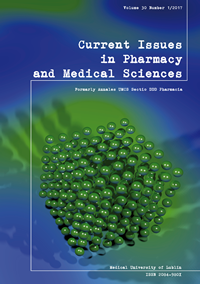Moderate dyslipoproteinemia induced inflammation and remodeling HDL and VLDL particles in post-renal transplant patients
DOI:
https://doi.org/10.1515/cipms-2017-0015Keywords:
VLDL, HDL, hsCRP, LPO, LCAT, PON1, CETP, renal transplantationAbstract
The aim of this paper was to examine whether moderate dyslipoproteinemia can cause an increase of hsCRP and LPO levels in Tx patients who had received immunosuppressive therapy and were without acute inflammatory diseases. Herein, the lipid levels, hsCRP, LPO, apolipoprotein (apo)B, AI, AII, AIInonB, apoB-containing AII (apoB:AII), apoCIII, apoCIIInonB, apoB:CIII, LCAT level, as well as CETP and PON1 activity were determined. All examined Tx patients had moderate dyslipidemia and slightly increased hsCRP, LPO, apoB:AII and apoCIII levels, but decreased LCAT mass, PON1 activity and lipoprotein ratios. Tx patients with apoAI<150 mg/dl (n=28) had worse lipoprotein profiles than did Tx patients with apoAI>150mg/dl (n=39), but no difference in CETP activity was indicated. Multiple ridge forward regression and Spearman’s correlation test were used. The results of the presented study, show for the first time that higher apoAI/apoB and apoAI/apoCIII ratios induced a decrease of the hsCRP concentration. Moreover, the composition of apoCIIInonB, LDL-C and apoAI brought about an increase of LCAT mass and PON1 activity. In Tx patients with lower concentration of apoAI, an increase of concentration of apoB:AII in VLDL generated a mild oxidation of lipoprotein and an elevated concentration of LPO. However, lower ApoAI/apoB ratio resulted in an increase of PON1 activity and apoB, as well as nonHDL-C levels, and in turn, PON1 activity increased LCAT mass. These disorders rearranged the HDL particle, and, simultaneously, remodeled the VLDL particle. This may prevent antioxidant activity, reverse cholesterol transport and accelerate the rejection of the transplant, as well as bringing about cardiovascular diseases in Tx patients with lower apoAI. Such metabolic pathways can be used as potentially novel targets for pharmacological intervention.
References
1. Abedini S. et al., Inflammation in renal transplantation. Clin. J. Am. Soc. Nephrol., 4, 1246, 2009.
2. Barn K. et al.: Low levels of high-density lipoprotein cholesterol: an independent risk factor for late adverse cardiovascular events in renal transplant recipients. Transpl. Intern., 23, 574, 2010.
3. Corsetti J.P. et al.: Apolipoprotein A-II influences apolipoprotein E-linked cardiovascular disease risk in women with high levels of HDL cholesterol and C-reactive protein. PLoS ONE, 7 e39110, 2012.
4. de la Lora Moya M. et al.: Inflammation modulates human HDL composition and function in vivo. Atherosclerosis, 222, 390, 2012.
5. Friedewald W.T., Levy R.I., Fredrickson D.S.: Estimation of the concentration of low-density lipoprotein cholesterol in plasma without the use of the preparative ultracentrifuge. Clin. Chem., 18 499, 1972.
6. Gao X., Jayaraman S., Gursky O.: Mild oxidation promotes and advanced oxidation prevents protein dissociation and remodeling of human plasma high-density lipoprotein in vitro. J. Mol. Biol., 376, 997, 2008.
7. Guha M., Gursky O.: Effects of Oxidation on Structural Stability and Remodeling of Human Very Low Density Lipoprotein. Biochemistry, 49, 9584, 2010.
8. Gungor O. et al. Serum paraoxonase 1 activity predicts arterial stiffness in renal transplant recipients. J. Atheroscler. Thromb., 18, 901, 2011.
9. Hine D., Mackness B., Mackness M.: Coincubation of PON1, apoAI, and LCAT increases the time HDL is able to prevent LDL oxidation. IUBMB Life, 64, 157, 2012.
10. Jonas A., Sweeny S.A., Herbert P.N.: Discoid complexes of A and C apolipoprotein with lipids and their reactions with lecithin:cholesterol acyltransferase. J. Biol. Chem., 259, 6369, 1984.
11. Kar S. et al.: Oxidized phospholipid content destabilizes the structure of reconstituted high density lipoprotein particles and changes their function. Biochim. Biophys. Acta, 1821, 1200, 2012.
12. Kimak E. et al.: Association between lipids, lipoproteins composition of HDL particles and triglyceride-rich lipoprotein, and LCAT and CETP activity in post-renal transplant patients. Cell Biochem. Biophys., 67, 695, 2013.
13. Kimak E., Solski J., Baranowicz-Gąszczyk I., Książek A.: Serum lipids, lipoproteins, oxidative stress parameters and paraoxonase 1 (PON-1) activity in post-renal transplant patients (Tx) with stable renal function and Tx patients without and with statins therapy. Annales UMCS, SECTIO DDD, 24, 41, 2011.
14. Kimak E. et al.: Association between moderately oxidized low-density lipoprotein and high-density lipoprotein particle subclass distribution in hemodialyzed and post-renal transplant patients. JZUS-B, 12, 365, 2011.
15. Lee D.M. et al.: Oxidative Stress and Inflammation in Renal Patients and Healthy Subjects. PLoS ONE, 6, e 22360, 2011.
16. Lusis A.J.: Atherosclerosis. Nature, 407, 233, 2000.
17. Nafar M. et al.: Oxidative stress in kidney transplantation, causes, consequences, and potential treatment. Iranian J. Kidn. Dis., 5, 357, 2011.
18. Ribas V. et al.: Human apolipoprotein A-II enrichment displaces paraoxonase from HDL and impairs its antioxidant properties: a new mechanism linking HDL protein composition and antiatherogenic potential. Circ. Res., 95, 789, 2004.
19. Scharama Y.C. et al.: Conversion to mycophenolate mofetil in conjunction with stepwise withdrawal of cyclosporine in stable renal transplant recipients. Transplant., 69, 376, 2000.
20. Tian L., Fu M.: The relationship between high density lipoprotein subclass profile and apolipoprotein concentrations. J. Endocrinol. Investig., 34, 461, 2011.
Downloads
Published
Issue
Section
License
Copyright (c) 2017 Authors

This work is licensed under a Creative Commons Attribution-NonCommercial-NoDerivatives 3.0 Unported License.


